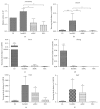Alkaline phosphatase in stem cells
- PMID: 25767512
- PMCID: PMC4342173
- DOI: 10.1155/2015/628368
Alkaline phosphatase in stem cells
Abstract
Alkaline phosphatase is an enzyme commonly expressed in almost all living organisms. In humans and other mammals, determinations of the expression and activity of alkaline phosphatase have frequently been used for cell determination in developmental studies and/or within clinical trials. Alkaline phosphatase also seems to be one of the key markers in the identification of pluripotent embryonic stem as well as related cells. However, alkaline phosphatases exist in some isoenzymes and isoforms, which have tissue specific expressions and functions. Here, the role of alkaline phosphatase as a stem cell marker is discussed in detail. First, we briefly summarize contemporary knowledge of mammalian alkaline phosphatases in general. Second, we focus on the known facts of its role in and potential significance for the identification of stem cells.
Figures


References
-
- Moss D. W. Alkaline phosphatase isoenzymes. Clinical Chemistry. 1982;28(10):2007–2016. - PubMed
Publication types
LinkOut - more resources
Full Text Sources
Other Literature Sources

